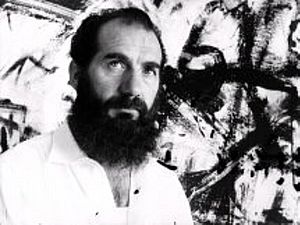Emilio Vedova facts for kids
Quick facts for kids
Emilio Vedova
|
|
|---|---|
 |
|
| Born | 9 August 1919 Venice, Veneto, Kingdom of Italy
|
| Died | 25 October 2006 |
| Nationality | Italian |
| Education | self-taught |
| Movement | Beyond Guernica, Gruppo degli Otto, Arte Informale |
| Awards | Cavaliere di Gran Croce della Repubblica Italiana |
Emilio Vedova (born August 9, 1919 – died October 25, 2006) was a very important Italian painter. He is known as one of the most significant artists from Italy's modern art scene. He was a key figure in the art movement called Arte Informale.
Contents
Early Life and Beginnings
Emilio Vedova was born in Venice, Italy. His family was working-class. His father was a house painter, which gave Emilio some early experience with art materials. Emilio was the third of seven children. He started working at a young age. He first worked in a factory. Later, he found a job in a photography and restoration studio. This helped him learn more about images and art.
Becoming an Artist
Emilio Vedova was mostly a self-taught artist. He did take a few night classes to learn more. At first, his art was influenced by Expressionism. This style shows strong feelings and emotions. During World War II, he joined an art group called "Corrente" (1942–1943). Other famous artists like Renato Guttuso were part of this group. Emilio drew pictures of his experiences during the war. He also took part in the Italian resistance movement. This was a group fighting against the wartime government.
Vedova returned to Venice after the war. He became very important in the art world there. His work helped connect Italian art with the European avant-garde. This term means new and experimental art. His paintings became much more abstract. They used geometric shapes and colors to show the feelings of the time. In 1946, he helped write a statement called "Beyond Guernica." Many famous Italian artists signed this paper. In 1947, Vedova also started an art group called Fronte Nuovo delle Arti.
Growing Fame and Influence
In 1951, Emilio Vedova had his first solo art show in the United States. It was at the Catherine Viviano Gallery in New York. This show helped him get noticed by big art collectors. One famous collector was Peggy Guggenheim. In 1952, he joined an important art group called Gruppo degli Otto (Group of Eight). This group included artists like Afro and Turcato. They showed their art at the Venice Biennial. This exhibition is seen as the start of the Arte Informale art movement. Vedova's work also had a big impact on the Arte Povera group. This group used simple, everyday materials in their art.
Vedova also worked with a famous composer named Luigi Nono. He designed the sets and costumes for Nono's opera Intolleranza 1960. In 1984, he created amazing light designs for Nono's opera Prometeo. This show was at the famous La Fenice theater. Nono even dedicated one of his music pieces to Vedova.
Vedova's art was shown in many galleries and museums. These included the Galleria Nazionale d'Arte Moderna in Rome. His work was also displayed at the Peggy Guggenheim Collection in Venice. His paintings have been very popular at art auctions. Vedova lived most of his life in Venice. He also taught art at the Accademia di Belle Arti.
Awards and Recognition
Emilio Vedova received many awards for his amazing contributions to art. He also had many solo shows.
- In 1951, he won a prize for young painters. This was at the first São Paulo Biennial in Brazil.
- In 1956, he won a Guggenheim International award.
- In 1960, he received the Grand Prize for painting at the Venice Biennale. This is a very important art exhibition.
See also
 In Spanish: Emilio Vedova para niños
In Spanish: Emilio Vedova para niños

